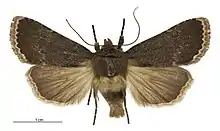| Bityla sericea | |
|---|---|
 | |
| Female | |
.jpg.webp) | |
| Male | |
| Scientific classification | |
| Domain: | Eukaryota |
| Kingdom: | Animalia |
| Phylum: | Arthropoda |
| Class: | Insecta |
| Order: | Lepidoptera |
| Superfamily: | Noctuoidea |
| Family: | Noctuidae |
| Genus: | Bityla |
| Species: | B. sericea |
| Binomial name | |
| Bityla sericea | |
| Synonyms[1] | |
| |
Bityla sericea is a species of moth in the family Noctuidae. This species is endemic to New Zealand. It is classified as "At Risk, Naturally Uncommon" by the New Zealand Department of Conservation.
Taxonomy
This species was first described by Arthur Gardiner Butler in 1877 using a specimen obtained from John Enys and collected in the South Island.[1][2] George Hudson discussed and illustrated this species both in his 1898 book, New Zealand moths and butterflies (Macro-lepidoptera) and his 1928 publication The Butterflies and Moths of New Zealand.[3][4] In 1905 Hudson, thinking he was describing a new species, also gave the species the name Orthosia pallida.[5] George Francis Hampson, also mistakenly believing this was a separate species placed O. pallida in the genus Bityla.[6] Hudson discussed B. pallida in his 1928 publication.[4] John S. Dugdale synonymised B. pallida with B. sericea in 1988.[1] The holotype specimen of B. sericea is held at the Natural History Museum, London.[1]
Description

Butler described the species as follows:
Primaries shining greyish brown, crossed by two widely separated and slightly diverging dusky lines, the inner one in the shape of a } , the outer one composed of small lunules with whitish exterior margins ; outer margin undulated, fringe silky whitish ; secondaries pale brown, fringe sandy whitish ; thorax greyish brown,' collar slightly darker ; abdomen ? : primaries below pale grey, costa and fringe whitish ; secondaries whitish, with a submarginal indistinct grey band, and the outer border, of the same tint, fringe whitish; pectus sandy yellowish, dusky in front ; legs sandy yellowish, banded with black. Expanse of wings 1 inch 6 lines.[2]
Although similar in appearance to Bityla defigurata, B. sericea can be distinguished from it as B. sericea has a pale fringe on its forewing.[7]
Distribution
This species is endemic to New Zealand.[8][9] The species has been found in Wellington, Marlborough, North Canterbury, Mid Canterbury, Central Otago and at the Otago Lakes areas.[10] Hudson mentions the species was also collected in Thames[4] and in Napier.[5]
Behaviour and life cycle
The adult moths are on the wing from February to May.[4] They are attracted to light.[3]
Host species and habitat
The host of the larvae of B. sericea is unknown but they probably feed on Muehlenbeckia species.[10]
Conservation status
This species has been classified as having the "At Risk, Naturally Uncommon" conservation status under the New Zealand Threat Classification System.[11]
References
- 1 2 3 4 5 Dugdale, J. S. (1988). "Lepidoptera - annotated catalogue, and keys to family-group taxa" (PDF). Fauna of New Zealand. 14: 195. Archived from the original (PDF) on 27 January 2019. Retrieved 9 July 2017.
- 1 2 Butler, Arthur Gardiner (1877). "On two Collections of Heterocerous Lepidoptera from New Zealand, with descriptions of new Genera and Species". Proceedings of the Zoological Society of London. 1877: 379–407 – via Biodiversity Heritage Library.
- 1 2 Hudson, G. V. (1898). New Zealand moths and butterflies (Macro-lepidoptera). London: West, Newman & Co. pp. 29–30. doi:10.5962/bhl.title.7912. Retrieved 19 May 2018.
- 1 2 3 4 Hudson, G. V. (1928). The Butterflies and Moths of New Zealand. Wellington: Ferguson & Osborn Ltd. p. 76.
- 1 2 Hudson, G. V. (1905). "On some new species of macro-lepidoptera in New Zealand". Transactions and Proceedings of the New Zealand Institute. 37: 355–358 – via Biodiversity Heritage Library.
- ↑ Hampson, George Francis (1908). "Catalogue of the Lepidoptera Noctuidae in the British museum". Catalogue of the Lepidoptera Phalaena in the British Museum. 7: 1–709 – via Biodiversity Heritage Library.
- ↑ Pawson, Stephen M.; Emberson, Rowan M. (2000). "The conservation status of invertebrates in Canterbury". Conservation Advisory Science Notes. hdl:10182/1658. ISSN 1171-9834.
- ↑ "Bityla sericea Butler, 1877". www.nzor.org.nz. Landcare Research New Zealand Ltd. Retrieved 2017-05-13.
- ↑ Gordon, Dennis P., ed. (2010). New Zealand inventory of biodiversity: Kingdom animalia : chaetognatha, ecdysozoa, ichnofossils. Vol. 2. p. 457. ISBN 978-1-877257-93-3. OCLC 973607714. OL 25288394M. Wikidata Q45922947.
- 1 2 Patrick, Brian; Dugdale, John S. (2000). Conservation status of the New Zealand Lepidoptera (PDF). Wellington, New Zealand: Department of Conservation. p. 20. ISBN 0478218672. Archived from the original (PDF) on 2017-05-01. Retrieved 2017-08-23.
- ↑ Hoare, R.J.B.; Dugdale, J.S.; Edwards, E.D.; Gibbs, G.W.; Patrick, B.H.; Hitchmough, R.A.; Rolfe, J.R. (2017). "Conservation status of New Zealand butterflies and moths (Lepidoptera), 2015" (PDF). New Zealand Threat Classification Series. 20: 8.
External links